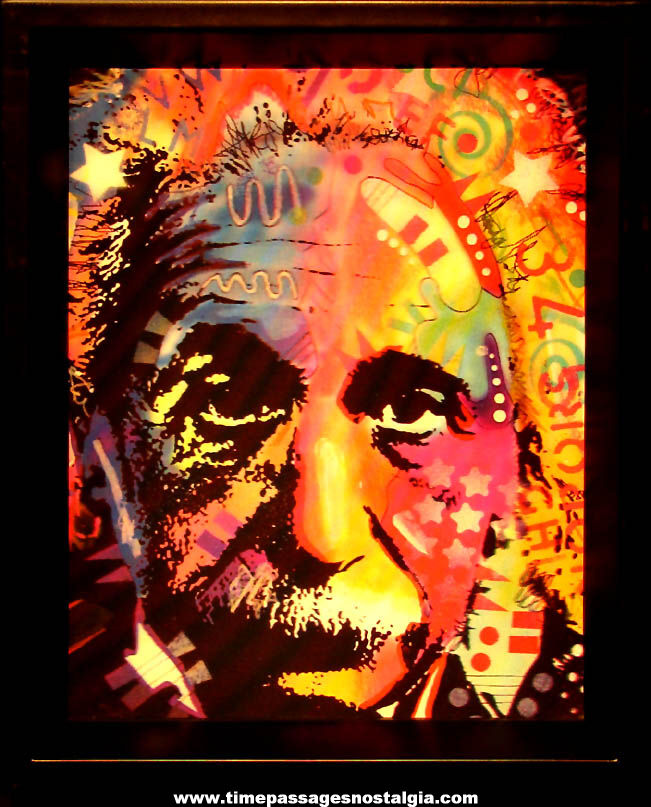
 | Item #o553 | 
Price: $24.99
$10 shipping & handling
For Sale
|
|
  | | Any group of items being offered as a lot must be sold as a lot. | | | It's never too late to
have a happy childhood! | | Worldwide Sales | Quality Packing And
Postal Insurance | | We have an extensive inventory that is not yet on our web site. If there is something you are looking for and did not find, please send us your wish list. | Whether you've collected Memorabilia for years or just want to feel like a kid again, please take a few moments to browse through what we
have available for sale. | Great memories
make great gifts! | | Quality Merchandise At Reasonable Prices | You can feel secure
shopping with PayPal. |
| | | | The picture below shows a larger view of this Colorful Framed Albert Einstein 3D Flicker Lenticular Picture. The picture is not dated and the year that it was made is unknown. Since the back is sealed we do not know if there is a maker’s name, and the maker is unknown. The picture is in a deep black plastic frame, the back is sealed, and there is hardware for hanging. The Albert Einstein image is of his head or face, with various colorful items or symbols all around. A very nice Art or artistic image. The 3-D picture with the frame measures about 9-1/4'' x 11-1/4'' x 1-3/4''. It appears to be in mint unused condition as pictured. Below here is a little background information on Albert Einstein: Albert Einstein
From Wikipedia, the free encyclopedia Born: 14 March 1879 - Ulm, Kingdom of Württemberg, German Empire
Died: 18 April 1955 (aged 76) - Princeton, New Jersey, United States
Residence: Germany, Italy, Switzerland, Austria (present day Czech Republic), Belgium, United States
Citizenship: Subject of the Kingdom of Württemberg during the German Empire (1879 – 1896), Stateless (1896 – 1901), Citizen of Switzerland (1901 – 1955), Austrian subject of the Austro-Hungarian Empire (1911 – 1912), Subject of the Kingdom of Prussia during the German Empire (1914 – 1918), German citizen of the Free State of Prussia (Weimar Republic, 1918 – 1933), Citizen of the United States (1940 - 1955)
Education: Federal polytechnic school (1896 - 1900; B.A., 1900), University of Zurich (Ph.D., 1905)
Known for: General relativity, Special relativity, Photoelectric effect, E=mc2 (Mass–energy equivalence), E=hf (Planck–Einstein relation), Theory of Brownian motion, Einstein field equations, Bose–Einstein statistics, Bose–Einstein condensate, Gravitational wave, Cosmological constant, Unified field theory, EPR paradox, Ensemble interpretation
Spouses: Mileva Marić (m. 1903; div. 1919), Elsa Löwenthal (m. 1919; died 1936)
Children: “Lieserl” Einstein, Hans Albert Einstein, Eduard “Tete” Einstein
Awards: Barnard Medal (1920), Nobel Prize in Physics (1921), Matteucci Medal (1921), ForMemRS (1921), Copley Medal (1925), Gold Medal of the Royal Astronomical Society (1926), Max Planck Medal (1929), Member of the National Academy of Sciences (1942), Time Person of the Century (1999)
Scientific career
Fields: Physics, Philosophy
Institutions: Swiss Patent Office (Bern) (1902 – 1909), University of Bern (1908 – 1909), University of Zurich (1909 – 1911), Charles University in Prague (1911 – 1912), ETH Zurich (1912 – 1914), Prussian Academy of Sciences (1914 – 1933), Humboldt University of Berlin (1914 – 1933), Kaiser Wilhelm Institute (director, 1917 – 1933), German Physical Society (president, 1916 – 1918), Leiden University (visits, 1920), Institute for Advanced Study (1933 – 1955), Caltech (visits, 1931 – 1933), University of Oxford (visits, 1931 - 1933)
Thesis: Eine neue Bestimmung der Moleküldimensionen (A New Determination of Molecular Dimensions) (1905)
Doctoral advisor: Alfred Kleiner
Other academic advisors: Heinrich Friedrich Weber
Influences: Arthur Schopenhauer, Baruch Spinoza, Bernhard Riemann, David Hume, Ernst Mach, Hendrik, Lorentz, Hermann Minkowski, Isaac Newton, James Clerk Maxwell, Michele Besso, Moritz Schlick, Thomas Young
Influenced: Virtually all modern physicsAlbert Einstein 14 March 1879 - 18 April 1955) was a German born theoretical physicist who developed the theory of relativity, one of the two pillars of modern physics (alongside quantum mechanics). His work is also known for its influence on the philosophy of science. He is best known to the general public for his mass–energy equivalence formula E=mc2. E = mc^2, which has been dubbed “the world’s most famous equation”. He received the 1921 Nobel Prize in Physics “for his services to theoretical physics, and especially for his discovery of the law of the photoelectric effect”, a pivotal step in the development of quantum theory. Near the beginning of his career, Einstein thought that Newtonian mechanics was no longer enough to reconcile the laws of classical mechanics with the laws of the electromagnetic field. This led him to develop his special theory of relativity during his time at the Swiss Patent Office in Bern (1902 - 1909). However, he realized that the principle of relativity could also be extended to gravitational fields, and he published a paper on general relativity in 1916 with his theory of gravitation. He continued to deal with problems of statistical mechanics and quantum theory, which led to his explanations of particle theory and the motion of molecules. He also investigated the thermal properties of light which laid the foundation of the photon theory of light. In 1917, he applied the general theory of relativity to model the structure of the universe. Except for one year in Prague, Einstein lived in Switzerland between 1895 and 1914, during which time he renounced his German citizenship in 1896, then received his academic diploma from the Swiss federal polytechnic school (later the Eidgenössische Technische Hochschule, ETH) in Zürich in 1900. After being stateless for more than five years, he acquired Swiss citizenship in 1901, which he kept for the rest of his life. In 1905, he was awarded a PhD by the University of Zurich. The same year, he published four groundbreaking papers during his renowned annus mirabilis (miracle year) which brought him to the notice of the academic world at the age of 26. Einstein taught theoretical physics at Zurich between 1912 and 1914, before he left for Berlin, where he was elected to the Prussian Academy of Sciences. In 1933, while Einstein was visiting the United States, Adolf Hitler came to power. Because of his Jewish background, Einstein did not return to Germany. He settled in the United States and became an American citizen in 1940. On the eve of World War II, he endorsed a letter to President Franklin D. Roosevelt alerting him to the potential development of “extremely powerful bombs of a new type” and recommending that the United States begin similar research. This eventually led to the Manhattan Project. Einstein supported the Allies, but he generally denounced the idea of using nuclear fission as a weapon. He signed the Russell–Einstein Manifesto with British philosopher Bertrand Russell, which highlighted the danger of nuclear weapons. He was affiliated with the Institute for Advanced Study in Princeton, New Jersey, until his death in 1955. Einstein published more than 300 scientific papers and more than 150 non-scientific works. His intellectual achievements and originality have made the word “Einstein” synonymous with “genius”. Eugene Wigner wrote of Einstein in comparison to his contemporaries that “Einstein’s understanding was deeper even than Jancsi von Neumann's. His mind was both more penetrating and more original than von Neumann’s”, and that is a very remarkable statement. |
|
Click on image to zoom.
 |